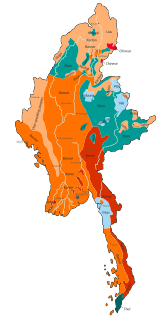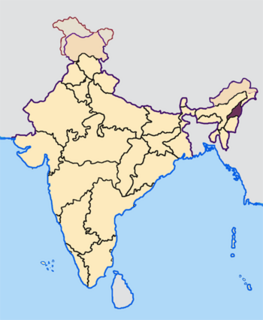
Myanmar is divided into twenty-one administrative subdivisions, which include:

There are approximately a hundred languages spoken in Myanmar. Burmese, spoken by two thirds of the population, is the official language.

Leshi, is a town in Naga Hills of Sagaing Division on the north-west frontier of Burma. According to the new 2008 Constitution of the military regime, it will now be grouped together with Lahe and Nanyun in Naga Self-Administered Zone. Leshi is reached via Htamanthi across the Chindwin River by boat from Homalin, and there are domestic flights from Yangon and Mandalay to Homalin.

The Ao languages or Central Naga languages are a small family of Sino-Tibetan languages spoken by the Ao of north-central Nagaland in northeast India. Conventionally classified as "Naga", they are not clearly related to other Naga languages, and are conservatively classified as an independent branch of Sino-Tibetan, pending further research. There are around 607,000 speakers of the languages in total.
Fuche Naw or Anong[ɑ˧˩nuŋ˧˥], is a Sino-Tibetan language spoken by the Nung people in Fugong County, China and Kachin State, Burma. Anong language is closely related to the Derung and Rawang languages. Most of the Anong people in China have shifted to Lisu.

Ponyo is a village in Lahe Township, Naga Self-Administered Zone, in the Sagaing Region of northwestern Burma. It is located on the border with India and lies at the headwaters of the Namteik Kha river.
Tangsa, also Tase and Tase Naga, is a Sino-Tibetan languages or language cluster spoken by the Tangsa people of Burma and north-eastern India. Some varieties, such as Shangge, are likely distinct languages. There are about 60,000 speakers in Burma and 40,000 speakers in India.
Tai Laing, pronounced Tai Lai or regionally Tai Nai, is a Tai language of Burma, related to Khamti. It has its own script, and, though not taught in schools, is experiencing a cultural revival, albeit still small. There is no census of speakers, but they are estimated to number around 100,000.
Somra, also known as Burmese Tangkhul, is a Sino-Tibetan language spoken in Burma. The two ethnic Tangkhul languages are related, but are not mutually intelligible, being only 30% lexically similar. Somra is closer to Akyaung Ari.
Akyaung Ari, or Ngachan, is a Tangkhulic language spoken in Burma. It is most closely related to Somra. It is spoken in Heinkut, Jagram, and Ngachan villages of Leshi Township, Sagaing Division, Myanmar.
Leinong Naga, or Htang Ngan, is a Sino-Tibetan language spoken in Burma. Leinong Naga is spoken in about 25 villages of Lahe Township and northwestern Hkamti Township, Naga Self-Administered Zone, Sagaing Division, Myanmar (Ethnologue). Dialects are Yao Dyang and Southern Leinong (Ethnologue).
Ponyo, or Ponyo-Gongwang after its two dialects, is a Sino-Tibetan language spoken in Burma. Ponyo is spoken in 19 villages of Lahe Township, Naga Self-Administered Zone, Sagaing Division, Myanmar (Ethnologue). Dialects are Ponyo and Gongwang, with high mutual intelligibility between the two.
Koki, or Koki Naga, is an unclassified Sino-Tibetan language spoken in Burma. Speakers are included under the wider Naga ethnicity. It has been documented in Shintani (2018).
Long Phuri, or Long Phuri Naga, is an unclassified Naga language of Burma. It is not close to other Naga languages which it has been compared to, though Long Phuri Naga, Makuri Naga, and Para Naga may be closest to each other.
Makury, or Makury Naga, is a Naga language of India and Burma. Shi (2009:3) and Saul (2005:25) suggest that Makury may be an Ao language.
Para or Para Naga, is an unclassified Naga language of Burma. It is not close to other Naga languages which it has been compared to, though Para Naga, Long Phuri Naga, and Makuri Naga may be closest to each other, with Para the most distinct. Barkman (2014) notes that Para Naga could possibly be an Ao or Tangkhulic language. Saul (2005) classifies Para Naga as an Ao language.





